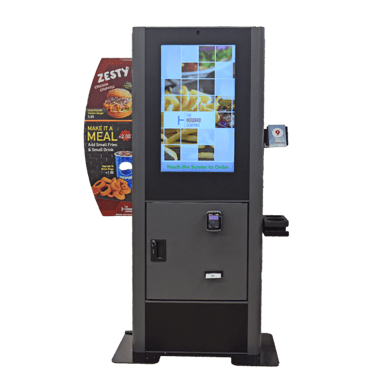 Every so often a new technology comes along that fundamentally changes the way we lead our lives. “The U.S economy is in the midst of a wrenching technological transformation that is fundamentally changing the way people sleep, work, eat, shop, love, read, and interact.” (Derek Thompson, The Atlantic).Is the self-ordering kiosk part of this? The momentum to add self-ordering kiosk in so many businesses seems unstoppable. It wasn’t too long ago that people barely used the self-checkout lines at grocery stores while people lined up in cashiers’ lines. Now the real estate for self-checkout is growing. Is this also going to happen in the restaurant industry? As with any change in technology, there may be consequences beyond the obvious. Let’s explore a few.
Every so often a new technology comes along that fundamentally changes the way we lead our lives. “The U.S economy is in the midst of a wrenching technological transformation that is fundamentally changing the way people sleep, work, eat, shop, love, read, and interact.” (Derek Thompson, The Atlantic).Is the self-ordering kiosk part of this? The momentum to add self-ordering kiosk in so many businesses seems unstoppable. It wasn’t too long ago that people barely used the self-checkout lines at grocery stores while people lined up in cashiers’ lines. Now the real estate for self-checkout is growing. Is this also going to happen in the restaurant industry? As with any change in technology, there may be consequences beyond the obvious. Let’s explore a few.
How Will Self Ordering Kiosks Impact Employment, Especially at Entry Levels?
There is little doubt that adding kiosks will take jobs away from people who work as cashiers. However, is it possible that the job title and description will change, but the positions will remain? Although the function of taking orders and accepting payment may disappear, order fulfillment will not. Somebody still has to deliver the order from the kitchen to the customer.
Most businesses add kiosks because they anticipate a growth in sales volume. Increased sales volume means more people employed in the production of the product in restaurants, and keeping shelves stocked in convenience stores and grocery stores. Since most people will expect an increase in efficiency due to the technology, businesses will be under pressure to be more efficient and produce orders at least as quickly as before. Kiosk or not, during the busiest times of the day they can’t afford to be short-staffed.
Kiosks Will Damage the Customer Experience
It may be an irreversible generational shift. “Screen time is bad for you. We never talk to each other anymore. I’m certain I will get what I want if I talk to a real person.” Those might be the words of people who are wringing their hands about runaway technology taking over every aspect of our lives. “I don’t want to wait in line. It’s easier if I do it myself. I would rather not talk to anybody.” Those may be the thoughts of the massive millennial generation. So who is right? The answer is probably both. The experience is in the eye of the beholder.
In some settings, a kiosk would not be appropriate. Fine dining will likely be very slow to adopt this technology because people are paying for the experience as much as the food. They want to be “waited on,” and they expect personal attention. High-end grocers and specialty shops like butchers might also be slower to adopt the technology. Again, shoppers who patronize this kind of business most likely go in with a completely different expectation.
For customers immersed in a digital world for most of their lives, and for those who have embraced it despite not having been born into it, kiosks are a welcome enhancement to the experience. In a fast-paced, instant gratification world, seeing a long line to order at a restaurant can be an instant turn-off. With so many options available, the second choice place next door that has a much shorter line can look pretty attractive to somebody who is in a hurry. Similarly, we have become very accustomed to getting things just the way we like them. Using a kiosk system to pick exactly what we want seems more foolproof than having to explain it to a person who might not get it right.
Convenience is undoubtedly a factor in the customer experience. Having multiple order points in a store or restaurant allows people to get in and out quicker, providing order production keeps up. Having well-designed and well-placed menu boards will let guests decide what they want quickly, so when they get to the kiosk, they are ready to go. This convenience also relieves some guests’ stress. Studies show that customers feel compelled to quickly order when they sense the cashier glancing at the growing line forming behind them. They may even omit items they want because they can’t find them on the menu board.
Kiosks Don’t Upsell
Kiosks will take upselling to new levels in restaurants, and the analytics gained from the sales data will improve how operators set up their menus. Upselling by salespeople is unreliable. A computer will do it automatically on every sale. Using the same techniques employed by online retailers to make assumptions on what customers might be likely to add on, upselling can be done consistently based on prior transaction data. If loyalty programs are employed, the upselling can be tied even better to the individuals' previous purchases.
Turning $10 sales into $12 sales will have a significant impact on revenues, but there may be other hidden benefits. It may become evident that salespeople were suggesting the wrong items to add on to orders. Assumptions about what should or could be suggested may be incorrect. Businesses can quickly run tests on various menu combinations and add-ons. Studying the data may lead to unexpected menu mixes.
Restaurants and retail are changing rapidly. More businesses are providing up to the second product offerings and pricing using digital menu boards. Drive-thru systems are not just for restaurants anymore. Pre-ordering with pick-up and delivery is common. Kiosks are the latest innovation. Their growth might not qualify as a disruption because they are not creating a new industry that completely supplants what came before it. Neither can their advent be considered a revolution because we will not see a complete overhaul of how businesses deliver goods to customers. Perhaps the proper term is evolution. The self-ordering kiosk seems to be the next logical step in the development of the restaurant and retail industries.
Editor's Note: This post was originally published in July 2018 and has been updated for clarity and accuracy.

